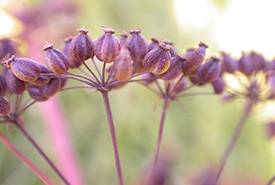
Victorin’s water-hemlock (photo by Frederic Coursol)
Victorin's water-hemlock
What does it look like?
Victorin’s water-hemlock is a perennial plant with a thin, hollow stem measuring half a metre to two metres in height, which is often streaked with purple. Its leaves are 10 to 80 centimetres in length, with narrow white flowers that produce small, brownish fruit from August to October. All parts of the plant are toxic to mammals.
Where does it grow?
One of four varieties of the water hemlock species, this plant is found only in Quebec and nowhere else in the world. It grows in fresh water or slightly brackish tidal marsh areas along the St. Lawrence River. The global population of Victorin’s water-hemlock occurs in less than 40 sites.
What threats does it face?
Victorin’s water-hemlock is threatened by development, including the infilling of shoreline, mowing of vegetation and recreational human activity. Its survival is limited by the specific tidal habitat that it needs.
What is its conservation status?
The Committee on the Status of Endangered Wildlife in Canada designated Victorin’s water-hemlock as special concern in 1987 and confirmed the assessment in 2004. The Province of Quebec published a conservation plan for it in 2007 and Environment and Climate Change Canada proposed a management plan for the species in 2011.
What is NCC doing to protect habitat for this species?
The Nature Conservancy of Canada (NCC) has protected several properties in Quebec where Victorin’s water-hemlock occurs, including the Jean-Paul-Riopelle Nature Reserve, a 48-hectare (120-acre) property on Isle-aux-Grues in the St. Lawrence River.





